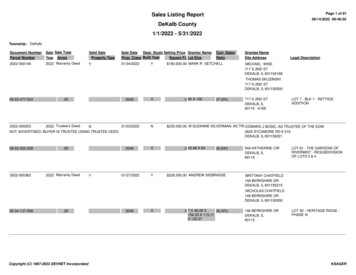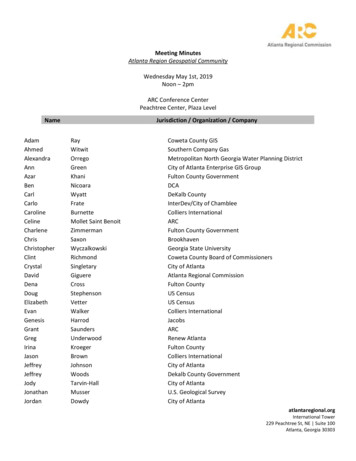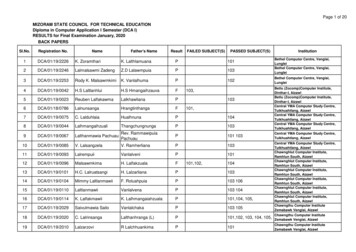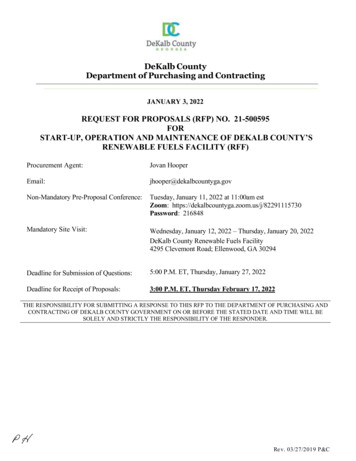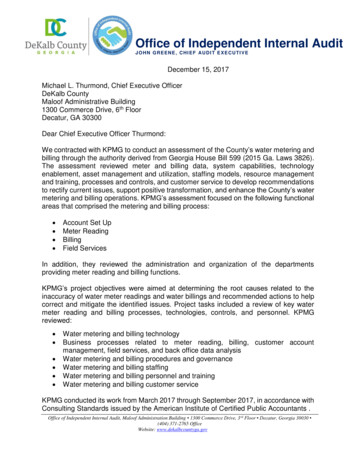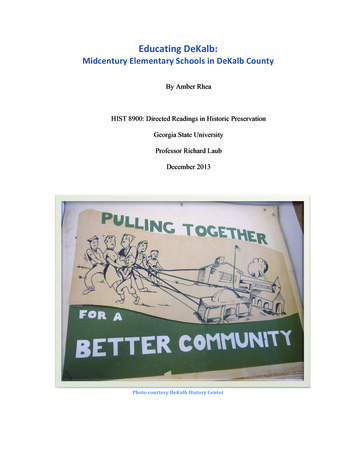
Transcription
bCountyBy Amber RheaHIST 8900: Directed Readings in Historic PreservationGeorgia State UniversityProfessor Richard LaubDecember 2013PhotocourtesyDeKalbHistoryCenter
TableofContentsIntroduction and Methodology .1From Cow Pastures to Ranch Houses .3“Our Children Cannot Wait” .5The DeKalb Model: The Neighborhood School 12National Register Significance 16Case Studies . .18Jim Cherry Elementary .19Lynwood Park School .21Robert Shaw Elementary 24Oak Grove Elementary 27Gresham Park Elementary .29Wadsworth Elementary .34Columbia Elementary .38Montgomery Elementary 39Henderson Mill Elementary 42Clifton Elementary .43Recommendations and Conclusion 46
Introduction and MethodologyThroughout DeKalb County, it appears again and again: the low, linear form witha continuous bank of awning windows and a façade of red or beige brick, often accentedwith stone or cast concrete. Nearly 100 schools in the county fit this general profile, andthey were all constructed within a 20-year period. Many of these schools are inremarkably close proximity to one another, and most are found within a plannedsubdivision. This report will demonstrate that the tremendous population growth DeKalbCounty experienced in the mid-twentieth century necessitated a complete overhaul of theschool system, including a massive building program that continued at a breakneck pacethrough the 1950s and 1960s. The case studies highlighted will show that theInternational style was universally employed in an effort to promote an image ofmodernity and efficiency, and that the elementary school was often an integralcomponent in midcentury residential subdivisions that, as a whole, were designed aroundthose same ideals.This report covers only elementary schools within the DeKalb County SchoolSystem; those that are City of Atlanta or City of Decatur schools are not included.Additionally, I chose to focus on schools constructed between 1950-1970 inside thePerimeter (I-285). Even though this is a somewhat arbitrary physical boundary since noPerimeter existed when most of these schools were built,1 it helped me focus my effortswhen faced with a staggering number of schools. The schools surveyed include thosebuilt both as white and African American facilities, as segregation was still in effect inDeKalb County up until the end of the 1960s. I conducted windshield surveys of all 441I-285 opened in 1968.1
schools and chose ten case studies that represent an accurate cross-section of the countyin terms of uses, conditions, and years of construction. The Appendix includes aspreadsheet with information on all 44 schools, including dates of construction, dates ofclosure or demolition (if applicable), original intended race, original enrollment numbers,and architects (if known). Developer’s plat maps were not available for most of the casestudies, due to issues at the courthouse such as incorrect placement or damaged originalfiles.Two essential sources of information were the Historic Preservation Division(HPD) of the Georgia Department of Natural Resources and the DeKalb History Center.HPD has a publication put out by the DeKalb County School System in 1972 entitled AQuarter Century of Education in DeKalb School System: 1947-1972, which surveys 25years of progress in the system and includes detailed information on Jim Cherry’s tenureas Superintendent of Schools, the financing plan for new school construction, and thecounty’s overarching plan for school improvement in terms of facilities, academics,nutrition, and more. HPD also has “history notebooks” that were kept on 29 of the 44schools, as well as on other schools that were not surveyed for this report. Thesenotebooks were obtained from the DeKalb County School System several years ago,before they moved to new headquarters. The notebooks were the brainchild of Jim Cherryand intended to tell the story of the school’s progress year by year – the principal wouldwrite the background history of the school, cover its statistics when it opened, and thenwrite an update at the end of each school year. Some notebooks are much more extensivethan others (some are nothing more than one boilerplate page with filled-in answers), butall in all they proved to be a valuable source of information, especially for facts such as2
architects and construction costs. Additionally, the DeKalb History Center has a file onalmost every school in the county, many of which contain valuable documents,photographs, and in a few cases, floor plans or architect’s renderings.The intent of this report is to foster an appreciation of these unique midcenturyschools, many of which are threatened with demolition or inappropriate renovation. Somehave already been lost. It is only by understanding the context in which these resourcesexist that we can fully appreciate their contribution to our history at both the local andnational level, and their lasting impact on the built environment.From Cow Pastures to Ranch HousesPrior to World War II, DeKalb County was mostly rural. A small portion of theCity of Atlanta extends into western DeKalb County, and development in the latenineteenth and early twentieth century had taken place in neighborhoods such asKirkwood and East Lake, which were served by a streetcar line from downtown Atlantaextending through Decatur, Clarkston, and out to Stone Mountain.2 Decatur, the countyseat, had been an urban population center as far back as the early 1800s, and there were ahandful of other concentrated population centers, such as in the small towns of Lithonia,Clarkston, and Avondale Estates. Dairy farms, other forms of agriculture, and thequarrying industry (near Stone Mountain and Lithonia) dominated the rest of the county.3The abundant natural resources and large swaths of open land provided excellent2Reed, Mary Beth, Patrick Sullivan, W. Matthew Tankersley, Sara Gale, and MaryHammock. Historic Streetcar Systems in Georgia. Atlanta, Ga.: New South Associatesfor the Georgia Department of Transportation, Jan. 31, 2012. PDF. 54, 69.3Single-Family Residential Development: DeKalb County, Georgia 1945-1970. GeorgiaState University, Spring 2010 Case Studies in Historic Preservation class, Apr. 2010.PDF. 21-22.3
conditions for dairy farming in particular, and by 1939, 200 dairies were operating inDeKalb County.4In the 1940s, things began to change dramatically. The combination of severalforces led to a population explosion in DeKalb County. Scott Candler, who served as thecounty’s sole commissioner from 1936-1955, actively worked to improve DeKalb’sinfrastructure by building new roads and improving existing ones, increasing theavailability of utilities, implementing biweekly residential garbage service, andoverseeing the development of the county’s first water treatment facility.5 Theseinfrastructure improvements laid the groundwork that allowed Candler to recruit newindustries, which in turn attracted new residents.With the end of World War II, DeKalb County experienced exponential populationgrowth as part of the nationwide “baby boom.” The birth rate soared through the late1940s and into the 1960s, leading to a nationwide housing shortage. The impact wascertainly felt in DeKalb County, where proximity to Atlanta and a surplus of cheap land,with owners willing to sell, fed a demand. The Servicemen’s Readjustment Act of 1944(often referred to as the G.I. Bill) made the American dream accessible to returningmembers of the armed forces, many of whom were able to purchase a home for the firsttime. With the baby boom, a majority of new households in DeKalb County includedyoung children – children who would soon need to attend school. Seemingly overnight,former dairy farms became residential subdivisions that adhered to Federal HousingAdministration minimum requirements for loan eligibility, as well as “desirable standards”recommended by the agency. These desirable standards included characteristics such as4Ibid. 22.5Ibid. 24-25.4
adaptation of subdivision features to the natural topography, curvilinear streets,elimination of sharp corners, and large lot sizes.6 DeKalb County has one of the largestconcentrations in the state of midcentury subdivision development – nearly 13,000 suchsubdivisions were created, with the ranch house as the predominant house type.7The phenomenon of “white flight” – white families leaving inner cityneighborhoods for the suburbs as black families moved into formerly all-white enclaves –can explain some of DeKalb County’s growth, but not all or even most of it. White flightdid not really take off in the Atlanta area until the middle to late 1960s (following theCivil Rights Movement, the Fair Housing Act, and federally mandated schooldesegregation), by which time DeKalb’s rapid growth was already well established.Although it is true that most of the newcomers to DeKalb County in the 1950s were white,the explanation lies more in the greater social mobility of middle class whites faced witha postwar housing shortage, combined with institutionalized segregation in which manynew subdivisions employed racially restrictive covenants that limited residents to eitherwhite or black. Additionally, in the 1960s, Census data shows that a majority of DeKalb’snew residents came from outside the Atlanta metropolitan area rather than within it.8“Our Children Cannot Wait”The amended Georgia Constitution of 1945 established the basis for free publicschools with financing provided via taxation. This legislative change provided the basis6Ames, David L., and Linda Flint McClelland. National Register Bulletin, HistoricResidential Suburbs: Guidelines for Evaluation and Documentation for the NationalRegister of Historic Places. U.S. Department of the Interior, National Park Service, lletins/suburbs/index.htm. Accessed Oct.24, 2013.7Single-Family Residential Development: DeKalb County, Georgia 1945-1970, op. cit.69.8Ibid. 52-53.5
for DeKalb County Schools to expand in accordance with the county’s population growth.When Jim Cherry became Superintendent of DeKalb County Schools in 1948, the ruralbut growing county had 23 elementary schools for white students, eight high schools forwhite students, and 17 schools for African American students. To hear Cherry and hiscontemporaries tell it, the school system was in a sorry state. This had not always been inthe case. In 1916, the Georgia Department of Education reported that the DeKalb Countyschool system was a model in education, noting, “We find here certainly a wellorganized school system. The same cannot be said of many Georgia counties as yet.”9 Ofcourse, in 1916, the demand on the school system was low, with a rural, widely dispersedpopulation. As the county’s population grew, however, the school system had difficultykeeping up. In 1946, over 9,000 children were enrolled in DeKalb County schools, andthe first baby boomers would soon be reaching school age. County officials could see thecoming storm of population growth, but they had no way to guess just how dramatic thatgrowth would actually be. Enrollment for the 1947-1948 school year was projected at11,000, a figure called “record breaking” by a local news reporter.10 Actual enrollmentfor that school year was 11,056, and in ten years, enrollment would triple to 33,694.11In the late 1940s, the DeKalb County school system was nearing a crisis point,with “schools [that] were beset with problems related to inequitable educationalopportunities, inadequate services, disparity in taxation, a lack of uniform policies” and9Horne, Sydney B. A Quarter Century of Education in DeKalb School System: 19471972. DeKalb County Schools, 1972. DeKalb County Schools files, Georgia HistoricPreservation Division. ii.10Ibid. 3.11Ibid. 174.6
leaders who were “confused by the new problems and demands.”12 Following a GrandJury investigation into the condition of DeKalb County schools in February 1946, thecounty hired a consultant to “work with the physical and financial setup of the schoolsystem” and “serve as a liaison between the Superintendent and the Board ofEducation.”13 That consultant was Jim Cherry, then an employee of the GeorgiaDepartment of Education.During 1946 and 1947, Cherry conducted a complete survey of DeKalb Countyschools and analyzed the needs of the school system. On March 20, 1947, Cherrypresented his findings to the Board of Education. Based on the findings, the board set outto create standardized policies and procedures for the entire school system. Thefoundation from which the board agreed to operate was the premise that each child,regardless of background, was entitled to a decent education. Thus, “the individual pupilwas the justification for the teachers, the principal and the supervisors; the justificationfor the bus drivers, the maintenance personnel, the dishwashers and other supportingpersonnel.”14 Once the board had acceptance of this premise from stakeholders at alllevels, it was much easier to reorganize administration, staffing, and purchasing at thecounty level, because “this early concept served as the basis for confidence.”15Cherry’s influence was felt quickly. In 1947, he tried to resign from his duties as atemporary consultant, and the DeKalb New Era newspaper was besieged with lettersfrom citizens begging Cherry to stay. Amid a brewing financial and political scandal withthe current Superintendent and Board of Education, Cherry announced his candidacy for12Ibid. iii.13Ibid.14Ibid.15Ibid.7
Superintendent in 1948 and was elected. Immediately, he made it clear that under hisleadership, the DeKalb County school system would not fall victim to political infighting:“He could tolerate no political interference in the system and no criticism of the centraloffice or the school personnel who had done efficient work in the best interests of theschool system.”16 In 1951, Charles Davidson, Chairman of the DeKalb County Board ofEducation, remarked of Cherry, “[He] has within four years lifted our schools from astate of despair and an unbalanced budget to a feeling of enthusiasm and sound financialstatus.”17Superintendent Cherry saw that DeKalb County was growing at an unprecedentedpace, and that a massive, highly organized building and hiring program would need to beundertaken to provide for the education of all the new children in the county. As isevident in his work with school system personnel of all levels, Cherry understood theimportance of having buy-in from those who are most affected by financial andorganizational changes. It is probably for this reason that he penned the influentialeditorial “Our Children Cannot Wait,” telling citizens that “[t]he people of Georgia wantno more pit toilets, ill-lighted classrooms and old-fashioned stoves in their schools. Theywill not stand for fire-trap buildings.”18 In another editorial, Cherry further stressed thepoint:The education program must not be static; it must be individualized anddynamic if the individual is to be fitted to fill an efficient place as a citizen16Ibid. 6.17DeKalb County Schools Collection, DeKalb History Center.18Horne, op. cit. 32.8
under the free enterprise system and the American way of life. Adequatepublic education for each child is the only insurance we can purchase forthe future of free men.19This sentiment favoring entitlement to a decent education is reminiscent of theProgressive era of the early twentieth century, and found a clear fit within a county thathad been rural and agrarian but was becoming industrialized and suburban in a very shortamount of time. Along these same lines of growth, the provision of an adequate educationwas closely tied with business development in DeKalb County. As an AtlantaConstitution editorial writer opined, “From the purely selfish standpoint of their ownfuture, businessmen have a major stake in our public schools.”20For a majority of DeKalb County children, regardless of race, this represented thefirst time they attended school in a facility equipped with modern conveniences such asheating and running water. The use of the International style, therefore, was not merelyan aesthetic choice used to represent an ideal of modernity, but a practical one as well, asthese buildings could easily accommodate the physical hallmarks of modernity – climatecontrol, a dedicated and efficient kitchen space, telephone service, and indoor plumbing.Another practical aspect of the International style was its cost-effectiveness: “The style’sclean lines, lack of ornament, and emphasis on modern materials and technology enabledschools to be built quickly and less expensively than traditional wood-frame or masonry19Cherry, Jim. “The DeKalb School Story.” DeKalb New Era [Decatur, Ga.] No date;assumed mid-1950s. In “Chronology of Knollwood School” notebook, DeKalb CountySchools files, Georgia Historic Preservation Division. Undated.20“Catfishin', Educatin'? Both Are Challenging.” Atlanta Constitution. Mar. 11, 1954. InA Quarter Century of Education in DeKalb School System: 1947-1972. 46.9
buildings.”21 This is not to say that aesthetic concerns did not factor at all in schoolconstruction; in fact, such matters played an important role in winning the confidence ofcitizens: “[I]n adopting the International Style, the State School Building Authority madean aesthetic break from previous generations of small, inadequate schools. The staterelied on the International Style, which appeared new and forward looking, to build astatewide system of schools that it hoped would embody the future of education inGeorgia.”22Funding for the new schools came from multiple sources. One of Jim Cherry’sfirst tasks as Superintendent was to oversee reform of the tax structure in DeKalb Countyin accordance with the 1945 Georgia Constitution, so that property taxes would be leviedon a system-wide basis, rather than the previous arrangement where taxes were levied byeight separate districts within the DeKalb County School System. With the old system,disparities in taxes from one district to another were “largely responsible for inequities inservices provided within the local districts.”23 The county contracted with a survey teamto undertake a countywide tax reevaluation of all property. This new, uniform taxstructure was an incentive to builders and helped spur rapid residential development inthe county.24In 1949, the state legislature under Governor Herman Talmadge passed theMinimum Foundation Program of Education, a “long-awaited source of funding from the21Moffson, Steven. Equalization Schools in Georgia’s African-American Communities,1951-1970. Sept. 20, 2010. Georgia Department of Natural Resources, HistoricPreservation Division. PDF. 12-13.22Ibid. 13.23Horne, op. cit. 9.24Ibid. 10.10
State to finance school operations.”25 Although DeKalb County was growing, Cherry waswell aware that the tax base was, at that time, insufficient to finance school improvementon its own and that he must look to the state for capital outlay. The Minimum FoundationProgram would be this source. Originally passed with the intent of “providing a qualifiedand professionally trained teacher for each boy and girl, a well designed and properlyequipped classroom, safe and adequate transportation and sufficient instructionalmaterials and facilities,”26 within a few years the Minimum Foundation Program had alsobecome “the primary means for the state to convince the federal courts of the validity ofthe ‘separate, but equal’ doctrine.”27 As school systems in Georgia constructed newAfrican American schools that appeared altogether as modern and efficient as new whiteschools, they pushed back on the 1954 Brown v. Board of Education ruling andmaintained segregation within these “equalization schools.”When the Minimum Foundation Program was passed, it provided Georgia with 30million dollars in funding. Still, in 1952, Cherry advocated for an additional five milliondollars in funding – and was successful in receiving it. Cherry was also instrumental inthe establishment of the Georgia School Building Authority, which was set up to controlstate funds for capital outlay purposes.28In the early 1950s, an estimated 50 new homes were being built in DeKalbCounty weekly, leading to 75 new children in DeKalb’s schools each Monday morning.29At the beginning of the 1952-1953 school year, the Board of Education called for a25Ibid. 27.26Ibid.27Moffson, op. cit. 39.28Horne, op. cit. 31.29Ibid. 32.11
3,300,000 bond issue for new buildings, which drew an overwhelming ten to onemajority vote. These funds, in addition to 2,500,000 in state funds, provided for abuilding program of 400 new classrooms in the county.30 In 1953, foreseeing thecontinued growth of the county, the Board of Education recommended a 20% taxincrease to keep up with DeKalb’s educational needs. The DeKalb County Grand Jurysupported this recommendation, and taxes were increased accordingly.31As the county’s population continued to grow at a rapid pace, the school systemonce again found itself financially strapped at the start of the 1956-1957 school year. InOctober 1956, the Board of Education won approval of an 11,000,000 bond issue for afour-year building program.32 This pattern would repeat throughout the 1960s as well,with the school system barely managing to stay ahead of the county’s population growthand meet the needs of students. Throughout the 1960s, the school system faced problemssuch as textbook shortages and the opening of new schools before they were truly readyfor occupancy, all in an effort to accommodate a student population that showed no signof slowing down.The DeKalb Model: The Neighborhood SchoolThe midcentury schools in DeKalb County were not built in a “one-off” fashion,with each school being conceived, funded, and built as an individual project. Instead,there was a coordinated, over-arching plan in place under Jim Cherry, still evident todayin the way these schools incorporate into the planned neighborhoods of which they are apart. For a period of time during the 1950s and 1960s, memos and official publications of30Ibid.31Ibid.32Ibid. 40.12
the DeKalb County school system bear the slogan, “The school cannot live apart from thecommunity.” This core value permeated the school construction program during that time.It is evident that the many new DeKalb County citizens took great pride in these schools,as they did in their brand new ranch houses in newly laid-out subdivisions.Driving through DeKalb County today, it can be surprising to see that manymidcentury schools are in very close proximity to one another. However, this placementwas intentional, not only to accommodate the very large population of young children,but to facilitate inclusivity of planned subdivisions (Figure H-1). Official DeKalb Countyschool system publications from the 1950s and 1960s that delineate attendance zones fornew schools specifically state that transportation by bus will not be provided, because thezone of attendance is a one-mile radius (often encompassing a single plannedsubdivision). The obvious intent was that most students would walk to school. ColumbiaElementary is one example of such an attendance zone (Figure H-2). Additionally,DeKalb County did not implement middle school until the 1970s, so elementary schoolwent through grade seven, meaning that students stayed in schools within their ownneighborhoods for a longer period of time. These intentional design factors reflect thesuburban idealism of the time, the concept that all a nuclear family needed could befound in or within close proximity to their Olmstedian neighborhood of modern, efficientranch houses.The placement of schools also reflects the racial segregation of the era in whichthey were built. Cherry supported an adequate education in modern, well-equippedfacilities for all children, regardless of race, and put considerable effort into ensuring thatDeKalb County’s schools for African Americans met those standards. At the same time,13
he, like many other white leaders of the time, was very invested in maintaining separationof the races. The schools built for African American students during Cherry’s tenure fitthe profile of equalization schools as identified by the Historic Preservation Division(HPD) of the Georgia Department of Natural Resources: “brick-faced, concrete-blockstructure[s], roofed with steel, asphalt, and gravel, partitioned with pastel-shadedconcrete-block walls, and floored with concrete.”33 In August 1954, in the wake of theBrown v. Board of Education decision, the Decatur News published excerpts from aspeech given by Cherry at the groundbreaking of the new Lithonia Elementary and HighSchool for Negroes, under the headline, “Cherry Stresses Validity of ‘Separate and Equal’Schools.” Cherry stated that “[t]he accomplishments of the DeKalb County Board ofEducation in the past several years in equalizing, improving and expanding schoolfacilities and services for Negro children give validity to the ‘equal and separate schools’argument,” adding that “[a]ny interruption of our plans to provide for our Negro childrenan adequate educational opportunity will come at the hand of Negroes.”34In the 1950s and into the 1960s, DeKalb County’s African American populationwas small and concentrated in a few parts of the county, mainly in the relatively higherdensity areas of Decatur, Clarkston, Lithonia, Stone Mountain, and Scottdale. There werealso small but longstanding African American communities at Mount Zion (near the OakGrove area) and Mount Moriah (near the present-day site of the Target shopping center atNorth Druid Hills Road and Briarcliff Road). Near Brookhaven, the Lynwood Park33Moffson, op. cit. 9.34“Cherry Stresses Validity of ‘Equal and Separate’ Schools.” Decatur News [Decatur,Ga.] Aug. 5, 1954.14
subdivision was developed in the 1930s specifically for African Americans.35 Accordingto the 1950 Census, DeKalb County’s African American population was 9% of thetotal.36 That number remained consistent throughout the decade of the 1950s, withAfrican Americans accounting for 8.6% of the population in 1960.37 By 1970, theAfrican American population had increased, but still made up only 13.7% of the total.38 Itmay seem odd that there were 17 schools for African American students prior to JimCherry’s tenure as Superintendent, since the African American population wascomparably so much smaller than the white population, but those existing schools weresmall and dilapidated, often one- or two-room schoolhouses located in remote parts of thecounty where students had to travel as far as five miles from their homes to attend. Someschools were held in church or lodge buildings rather than in separate, dedicatedfacilities.39Looking at the historical data, DeKalb’s midcentury school building program tookplace in two “waves” – one occurring from the early 1950s through 1958, and the othertaking off in the early 1960s. Although the overall form and design of the schools in bothperiods is essentially the same, there are enough distinct differences to constitutebreaking the schools into two separate categories. Architecturally, the earlier schools tendto use red brick and more windows, whereas the later schools favor beige brick and fewer35Single-Family Residential Development: DeKalb County, Georgia 1945-1970, op. cit.42, 53, 78.36Social Explorer - Census 1950 Race Only Set. Washington, D.C.: U.S. Census Bureauvia Social Explorer. Excel spreadsheet.37Social Explorer - Census 1960 Race Only Set. Washington, D.C.: U.S. Census Bureauvia Social Explorer. Excel spreadsheet.38Social Explorer - Census 1970 Race Only Set. Washington, D.C.: U.S. Census Bureauvia Social Explorer. Excel spreadsheet.39Harris, Narvie J., and Dee Taylor. African-American Education in DeKalb County:From the Collection of Narvie J. Harris. Charleston, SC: Arcadia, 1999. Print. 21.15
windows. The earlier schools are almost universally placed in the center of subdivisions,whereas the later schools, while still placed in or near subdivisions, have a greaternumber of examples placed along arterial roads or at the entrance to a subdivision ratherthan in its center. Finally, more of the later schools are found outside the Perimeter,reflecting the growing trend of families moving farther and farther from centralpopulation areas.National Register SignificanceDeKalb County’s midcentury schools are significant under National RegisterCriterion C as excellent examples of the International style tailored for use in educationalfacilities. As the case studies below will illustrate, most of these schools retain theirhistoric character-defining features and are still being used in their original capacity.Although many of the schools have had renovations and additions over the years, mosthave been done sensitively and were added to the rear of the building, where they do notobstruct the main façade or dramatically alter the surrounding landscape. The schools allfeature a low, linear profile of one story with a flat roof, awning windows, and brickveneer construction. The brick used in older (1950s) schools tends to be red, whereasbeige brick was used more in later (1960s) schools. Most schools make ample use ofconcrete as a complementary building material, either in the form of structural elementssuch as supports, pilasters, and overhangs, or in decorative cast components such asplanters or window surrounds. Some use stone (granite or marble) or tile as an additionalbuilding material, again both in practical and decorative ways. The school bu
Throughout DeKalb County, it appears again and again: the low, linear form with a continuous bank of awning windows and a façade of red or beige brick, often accented with stone or cast concrete. Nearly 100 schools in the county fit this general profile, and they were all constructed within a 20-year period.
